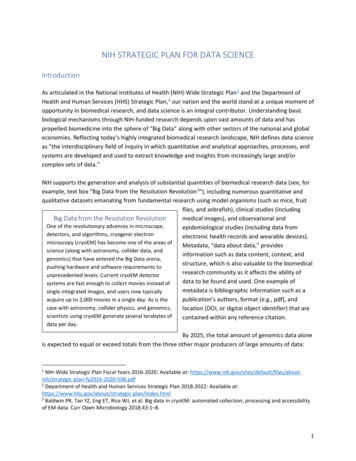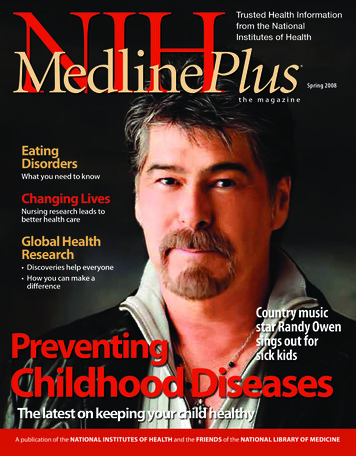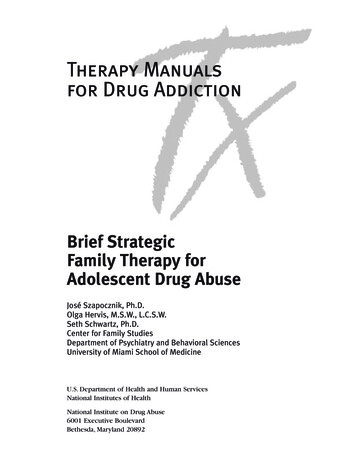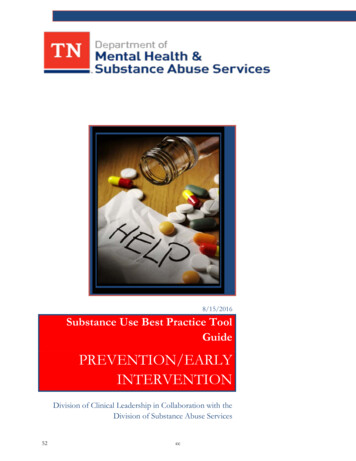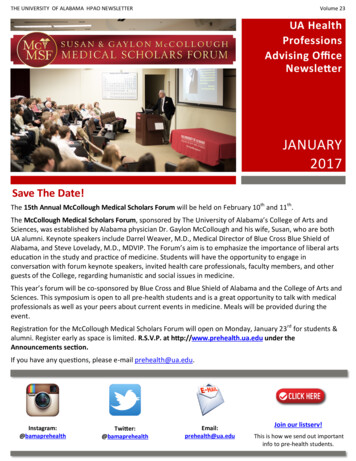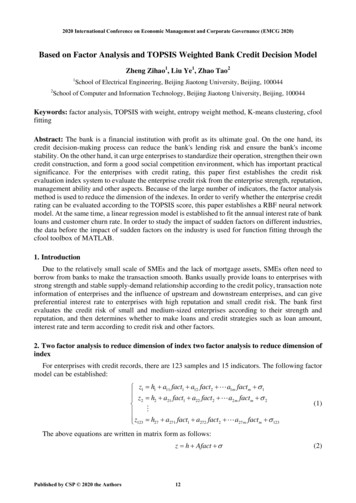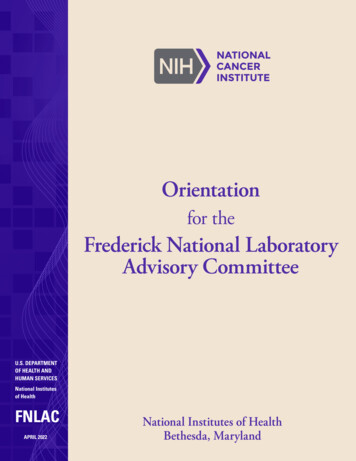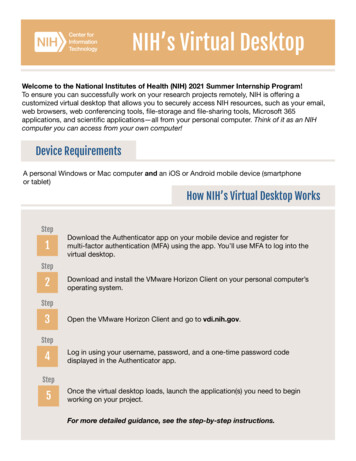
Transcription
Neurotransmission Fact SheetThe brain and nervous system are made of billions of nerve cells, called neurons. Neurons have three main parts:cell body, dendrites, and axon. The axon is covered by the myelin sheath.Dendrites receive messagesfrom other neurons.Cell Body is in charge of the neuron’sactivities.Myelin Sheath covers theaxon to protect it and helpmessages travel faster andeasier.Axon sends messages from the cellbody to the dendrites of other neurons.The transfer of information between neurons is called neurotransmission.This is how neurotransmission works:1. A message travels from the dendrites through the cell body and to the end of the axon.2. The message causes the chemicals, called neurotransmitters, to be released from the end of the axoninto the synapse. The neurotransmitters carry the message with them into the synapse. The synapse isthe space between the axon of one neuron and the dendrites of another neuron.3. The neurotransmitters then travel across the synapse to special places on the dendrites of the nextneuron, called receptors. The neurotransmitters fit into the receptors like keys in locks.4. Once the neurotransmitter has attached to the receptors of the second neuron, the message is passed on.5. The neurotransmitters are released from the receptors and are either broken down or go back into theaxon of the first neuron.Teacher copy: Module 1
Neurotransmission Fact SheetThe brain and nervous system are made of billions of nerve cells, called neurons. Neurons have three main parts:cell body, dendrites, and axon. The axon is covered by the myelin sheath.receivemessages from other neurons.neuron’s activities.is in charge of thecovers the axon to protectit and help messages travelfaster and easier.sends messages from the cellbody to the dendrites of other neurons.The transfer of information between neurons is called neurotransmission.This is how neurotransmission works:1. A message travels from the dendrites through the cell body and to the end of the axon.2. The message causes the chemicals, called neurotransmitters, to be released from the end of the axoninto the synapse. The neurotransmitters carry the message with them into the synapse. The synapse isthe space between the axon of one neuron and the dendrites of another neuron.3. The neurotransmitters then travel across the synapse to special places on the dendrites of the nextneuron, called receptors. The neurotransmitters fit into the receptors like keys in locks.4. Once the neurotransmitter has attached to the receptors of the second neuron, the message is passed on.5. The neurotransmitters are released from the receptors and are either broken down or go back into theaxon of the first neuron.Module 1
Neurotransmission Scavenger HuntAnswer Key1. The number of neurons in the brain is about 100 billion.2.The parts of neurons that send messages are the axons, and the parts of neurons that receivemessages are the dendrites.3.The space between the dendrites of one neuron and the axon of another neuron is called thesynapse.4.The nucleus of a neuron is where genetic material is stored.5.Neurons that send information from sensory organs, such as the skin or eyes, to the centralnervous system are called sensory (or afferent) neurons.6.Neurons that send information from the central nervous system to muscles or glands arecalled motor (or efferent) neurons.7.Poisons that affect neurotransmission are called neurotoxins.8.In the year 1921, a man named Otto Loewi first discovered neurotransmitters during anexperiment with two frog hearts.9.Glial cells are brain cells that do many important things that help neurons, including bringingnutrients to neurons, insulating parts of neurons, and digesting parts of dead neurons.Teacher copy: Module 1
Neurotransmission Scavenger HuntWork as quickly as you can to fill in all the blanks!1.The number of neurons in the brain is about .2.The parts of neurons that send messages are the , and the parts ofneurons that receive messages are the .3.The space between the dendrites of one neuron and the axon of another neuron is calledthe .4.The of a neuron is where genetic material is stored.5.Neurons that send information from sensory organs, such as the skin or eyes, to the centralnervous system are called neurons.6.Neurons that send information from the central nervous system to muscles or glands arecalled neurons.7.Poisons that affect neurotransmission are called .8.In the year , a man named firstdiscovered neurotransmitters during an experiment with two frog hearts.9.cells are brain cells that do many important things that helpneurons, including bringing nutrients to neurons, insulating parts of neurons, and digestingparts of dead neurons.Module 1
Brain Parts Fact SheetCerebral Cortex: Largest part of the brain Most highly developed part of the brain Controls thinking, perceiving, and understanding language Corpus callosum connects the two hemispheresHemispheres of the cerebral cortex:Right HemisphereLeft HemisphereControls the right side of the body Responsible for mathematical ability,problem solving, language, anddecision-making Controls the left side of the bodyResponsible for artistic expression andunderstanding relationships in spaceLobes of the cerebral cortex:Frontal LobeParietal LobeLocated below the crown of the head Processes sensory information from the whole body(information about pain, touch, and pressure) Located right behind the foreheadResponsible for initiating and coordinatingmotor movements and higher cognitiveskills like problem solving and thinkingTemporal LobeOccipital LobeLocated in the back of the brain, againstthe skull Processes all the visual informationcoming into the brain Located behind the temples and justabove the ears In charge of making sense of theinformation you hear Integrates information from varioussenses, such as smell and vision Hypothalamus: Controls body temperature, hunger, and thirstCerebellum: Controls posture, movement, and the sense of balanceBrain Stem: Brain’s most primitive part Controls simple reflexes, such as coughing, sneezing, and digestion Two main parts—pons and medulla Pons contains the fibers that connect the cerebral cortex withthe cerebellum and spinal cord; also controls sleeping,awakening, and dreaming Medulla controls heart rate, respiration, and blood pressure;connects the brain to the spinal cord* not visible by cross-sectionLimbic System: two main parts—hippocampus and amygdala Hippocampus controls learning and memory Amygdala plays an important role in emotional behaviorTeacher copy: Module 1
Brain Parts Fact SheetCerebral Cortex: Largest part of the brain Most highly developed part of the brain Controls thinking, perceiving, and understanding language Corpus callosum connects the two hemispheresHemispheres of the cerebral cortex: Controls the right side of the bodyResponsible for mathematical ability,problem solving, language, anddecision-making Controls the left side of the bodyResponsible for artistic expression andunderstanding relationships in spaceLobes of the cerebral cortex: Located below the crown of the headProcesses sensory information from the whole body(information about pain, touch, and pressure) Located right behind the foreheadResponsible for initiating and coordinatingmotor movements and higher cognitiveskills like problem solving and thinkingLocated behind the temples and justabove the ears In charge of making sense of theinformation you hear Integrates information from varioussenses, such as smell and vision Located in the back of the brain, againstthe skull Processes all the visual informationcoming into the brain Hypothalamus: Controls body temperature, hunger, and thirstCerebellum: Controls posture, movement, and the sense of balanceBrain Stem: Brain’s most primitive part Controls simple reflexes, such as coughing, sneezing, and digestion Two main parts—pons and medulla Pons contains the fibers that connect the cerebral cortex withthe cerebellum and spinal cord; also controls sleeping,awakening, and dreaming Medulla controls heart rate, respiration, and blood pressure;connects the brain to the spinal cord* not visible by cross-sectionLimbic System: two main parts—hippocampus and amygdala Hippocampus controls learning and memory Amygdala plays an important role in emotional behaviorModule 1
Nicotine and the BrainNonsmoker: Normal acetylcholine and receptorsAcetylcholine receptors help with respiration,heart rate, memory, alertness, muscle movement,pleasure, and well-being. In a synapse ofa nonsmoker, there is a normal amount ofacetylcholine and receptors, so the neuron isworking just like it should.New Smoker: Too many chemicals in the synapseNicotine is a similar shape to acetylcholine, so itfits into the same receptors. This makes neuron 1send messages much more often than it should.Addicted Smoker: Less acetylcholine and fewerreceptorsAfter a person has been smoking for a while,the brain decreases the amount of acetylcholineand the number of receptors. The brain doesthis to stop the neuron from sending too manymessages.Quitting “cold turkey”: Not enough acetylcholineand receptorsWhen nicotine use stops, the neuron is unableto send many messages because there is nolonger enough acetylcholine. There are alsofewer acetylcholine receptors. The user feelsuncomfortable and has withdrawal symptoms.Teacher copy: Module 2
Nicotine and the BrainNonsmoker:Acetylcholine receptors help with respiration,heart rate, memory, alertness, muscle movement,pleasure, and well-being. In a synapse ofa nonsmoker, there is a normal amount ofacetylcholine and receptors, so the neuron isworking just like it should.New Smoker:Nicotine is a similar shape to acetylcholine, so itfits into the same receptors. This makes neuron 1send messages much more often than it should.Addicted Smoker:After a person has been smoking for a while,the brain decreases the amount of acetylcholineand the number of receptors. The brain doesthis to stop the neuron from sending too manymessages.Quitting “cold turkey”:When nicotine use stops, the neuron is unableto send many messages because there is nolonger enough acetylcholine. There are alsofewer acetylcholine receptors. The user feelsuncomfortable and has withdrawal symptoms.Module 2
Alcohol and the BrainBrain PartAlcohol’s Effects on Brain PartsCerebral CortexWhen alcohol reaches this part of the brain, a person can lose judgmentand lower his or her inhibitions. Alcohol here also affects how the brain getsinformation from the senses, which might cause blurry vision and difficulty insmelling, tasting, and hearing.Frontal LobesThis lobe of the cerebral cortex helps a person with planning, makingdecisions, and using self-control. Alcohol can harm a person’s ability to plan,make decisions, and use self-control. If alcohol is used over a long period oftime, this part of the brain can be damaged permanently.HippocampusWhen alcohol reaches this part of the brain, a person can lose the ability toremember something he or she may have just learned, like another person’sname or a phone number. Drinking a lot of alcohol in a short period cancause a blackout, when a person cannot remember entire events. Long-termalcohol use can cause permanent memory and learning damage in this partof the brain.CerebellumThis part of the brain helps a person with thinking, coordination, balance,and being aware of everything around them. Alcohol interferes with theseabilities. Changes in this part of the brain may cause loss of balance andcoordination.HypothalamusWhen alcohol reaches this brain area, it can cause increased blood pressure,increased hunger and thirst, decreased body temperature, and a decreasedheart rate.MedullaDrinking alcohol interferes with this part of the brain’s ability to maintainthe body’s normal temperature. Alcohol can also cause slower breathing andheart rate. If a lot of alcohol is used over a short period of time, it can evencause a person to go into a coma when this part of the brain shuts down.Teacher copy: Module 2
Alcohol and the BrainBrain PartAlcohol’s Effects on Brain PartsWhen alcohol reaches this part of the brain, a person can lose judgmentand lower his or her inhibitions. Alcohol here also affects how the brain getsinformation from the senses, which might cause blurry vision and difficulty insmelling, tasting, and hearing.This lobe of the cerebral cortex helps a person with planning, makingdecisions, and using self-control. Alcohol can harm a person’s ability to plan,make decisions, and use self-control. If alcohol is used over a long period oftime, this part of the brain can be damaged permanently.When alcohol reaches this part of the brain, a person can lose the ability toremember something he or she may have just learned, like another person’sname or a phone number. Drinking a lot of alcohol in a short period cancause a blackout, when a person cannot remember entire events. Long-termalcohol use can cause permanent memory and learning damage in this partof the brain.This part of the brain helps a person with thinking, coordination, balance,and being aware of everything around them. Alcohol interferes with theseabilities. Changes in this part of the brain may cause loss of balance andcoordination.When alcohol reaches this brain area, it can cause increased blood pressure,increased hunger and thirst, decreased body temperature, and a decreasedheart rate.Drinking alcohol interferes with this part of the brain’s ability to maintainthe body’s normal temperature. Alcohol can also cause slower breathing andheart rate. If a lot of alcohol is used over a short period of time, it can evencause a person to go into a coma when this part of the brain shuts down.Module 2
Puzzle PiecesAcetylcholineNicotine has a similar chemical structureas this neurotransmitter and copies itsactionsWhat Causes NicotineWithdrawal?Nicotine has disrupted the normalrelationship between acetylcholine andits receptors, and now the brain needsnicotine to feel normalGABAAlcohol increases the activity of thisinhibitory neurotransmitterINHIBITORY NEUROTRANSMITTERDecreases the activity of neuronsEXCITATORYNEUROTRANSMITTERIncreases the activity of neuronsDOPAMINEThis neurotransmitter is a part of thebrain’s “reward system”HIPPOCAMPUSAlcohol can cause memory loss bydamaging this part of the brainLIVERThis part of the body works to removepoisons and germs from the blood, andcan be damaged by long-term alcoholabuseNICOTINEThe addictive drug found in tobaccoproducts like cigarettesTeacher copy: Module 2
Puzzle PiecesINHIBITORY NEUROTRANSMITTERNicotine has a similar chemical structureas this neurotransmitter and copies itsactionsEXCITATORYNEUROTRANSMITTERNicotine has disrupted the normalrelationship between acetylcholine andits receptors, and now the brain needsnicotine to feel normalLIVERAlcohol increases the activity of thisinhibitory neurotransmitterDOPAMINEDecreases the activity of neuronsHIPPOCAMPUSIncreases the activity of neuronsNICOTINEThis neurotransmitter is a part of thebrain’s “reward system”GABAAlcohol can cause memory loss bydamaging this part of the brainAcetylcholineThis part of the body works to removepoisons and germs from the blood, andcan be damaged by long-term alcoholabuseWhat Causes NicotineWithdrawal?The addictive drug found in tobaccoproducts like cigarettesModule 2
Prescription Drugs, Inhalants, and the Brain Fact SheetMorphine, codeine,Oxycodone (Oxycontin),Hydrocodone (Vicodin)ExampleBlock pain messages in brain byattaching to opioid receptorsHow are they supposed to work?Addiction, respiratory problems, deathAddiction, respiratory problems, deathWhat can happen when they are usedinappropriately?The following chart describes the effects of prescription drugs and inhalants when used appropriately and inappropriately.OpioidsPrescribed for painCause calmness by increasing GABAreleaseCNS StimulantsPrescribed for ADHD,narcolepsy, anddepressiondextroamphetamine(Dexedrine) andmethylphenidate(Ritalin)Cause increased alertness by copyingAddiction, irregular heart beat, high bodyactivity of dopamine and norepinephrine temperature, heart attack, seizuresCNS Depressantsbarbiturates andPrescribed for sleepbenzodiazepinesproblems and anxietyInhalantsSome householdproductsMeant for purposes other than inhalation Brain is deprived of oxygen, decreasedcoordination, heart attack, “sudden sniffingdeath”Conclusions:1. People should only take prescription drugs prescribed specifically for them by a doctor, and they should alwaysclosely follow the directions for use.2. Prescription drugs affect the brain and body. These changes can be harmful in someone that does not need them.3. Inhalants are household products that can be very dangerous if used inappropriately.Teacher copy: Module 3
Prescription Drugs, Inhalants, and the Brain Fact SheetHow are they supposed to work?Block pain messages in brain by attaching toopioid receptorsdextroamphetamine(Dexedrine) andmethylphenidate (Ritalin)Meant for purposes other than inhalationCause increased alertness by copying activityof dopamine and norepinephrineCause calmness by increasing GABA releaseSome household productsMorphine, codeine,Oxycodone (Oxycontin),Hydrocodone (Vicodin)barbiturates andbenzodiazepinesExampleWhat can happen when they are usedinappropriately?The following chart describes the effects of prescription drugs and inhalants when used appropriately and inappropriately.OpioidsPrescribed for painCNS DepressantsPrescribed for sleepproblems and anxietyCNS StimulantsPrescribed for ADHD,narcolepsy, anddepressionInhalantsConclusions:1.2.3.Module 3
Teacher Bingo Sheet1. This is the most commonly abused illegal drug in the United States. (Marijuana)2. This is the active chemical ingredient in marijuana. (THC)3. THC use can affect this function of the brain, which is the ability to retain information. (Memory)4. Marijuana is used medically to treat the side-effects of this cancer treatment. (Chemotherapy)5. The uncomfortable feeling or symptoms that one experiences when abruptly stopping marijuana use.(Withdrawal)6. Marijuana disrupts this system in the brain that is responsible for feelings and emotions, and plays animportant part in learning. (Limbic System)7. This poisonous gas is found in marijuana smoke. (Carbon Monoxide)8. Marijuana affects this ability to move, react, and stay balanced. (Coordination)9. A slang name for marijuana. (Weed)10. Marijuana comes from the dried flowers and leaves of this plant. (Cannabis)11. These are located on dendrites, and receive messages during neurotransmission. A specific one of these isactivated by THC. (Receptor)12. This neurotransmitter is associated with feelings of pleasure, and is affected by marijuana. (Dopamine)13. This part of the brain controls memory, and long term abuse of marijuana can permanently damage it.(Hippocampus)14 Marijuana disrupts this process in the brain which involves the sending and receiving of messages.(Neurotransmission)15. Long-term smoking of marijuana can lead to cancers and problems in this body organ. (Lung)16. The status of marijuana use in the United States for nonmedical purposes. (Illegal)17. This black liquid residue is found in marijuana smoke. (Tar)18. This is the most common method of using marijuana. (Smoking)19. The neurotransmitter that activates THC receptors. (Anandamine)20. These effects can last more than four hours after marijuana use, and can include distorted perception, reducedcoordination and balance, and sleepiness. (Short term)21. These effects can occur when marijuana is used heavily over a long period of time and can include personalitychanges and memory problems. (Long term)22. Long-term use of marijuana can cause personality changes, marked by a loss of this set of feelings that drivessomeone to achieve a goal. (Motivation)23. This part of the brain, which takes in information from the senses and is in charge of higher order thinking, isaffected by marijuana. (Cerebral Cortex)24. Marijuana affects this part of the brain, which coordinates movement. (Cerebellum)Teacher Copy: Module 4
Bingo CardLong ingCerebral CortexMotivationLimbic galShort termLungDopamineCarbon odule 4
Marijuana SurveyDo you think marijuana is safe for children and teens to use?A. alwaysB. sometimesC. neverD. not sureDo you think marijuana affects the brain?A. alwaysB. sometimesC. neverD. not sureDo you think marijuana can damage the brain or the body?A. alwaysB. sometimesC. neverD. not sureDo you know anyone who uses marijuana?A. yesB. noC. not sureStudents collected responses from their peers for each of the questions above. Use the chart below to tallythe results.Questionalwayssometimesnevernot sureyesnonot sureDo you thinkmarijuana is safe forchildren and teensto use?Do you thinkmarijuana affectsthe brain?Do you thinkmarijuana candamage the brain orthe body?QuestionDo you knowanyone who usesmarijuana?Teacher Copy: Module 4
Marijuana SurveyPlease fill out this survey. Your answers will be kept confidential.Do you think marijuana is safe for children or teens to use?A. alwaysB. sometimesC. neverD. not sureDo you think marijuana affects the brain?A. alwaysB. sometimesC. neverD. not sureDo you think marijuana can damage the brain or the body?A. alwaysB. sometimesC. neverD. not sureDo you know anyone who uses marijuana?Confiden ti alA. yesB. noC. not sureModule 4
Marijuana Fact SheetC (tetrahydrocannabinol) is the active ingredient in marijuana.THC activates THC receptors in the brain.These receptors are located in the:, andcerebral cortex,.When THC activates these receptors, it interferes with the normalfunctioning of these areas of the brain.Activity in thehippocampu is reduced when someone is using marijuana,causing problems with short-term memory. Long-term use can causepermanent memory lossand learning problems.The amount of tar, carbon monoxide, and cancer-causing chemicals can bein marijuana smoke than in tobacco smoke.Long-term marijuana users can becometo the drug.Module 4
Marijuana Fact SheetCTHC(tetrahydrocannabinol) is the active ingredient in marijuana.THC activates THCreceptorsThese receptors are located in the:cerebralcerebralcortexcortexin the brain.limbic system, andcerebellum,.When THC activates these receptors, it interferes with the normalnormalfunctioning of these areas of the brain.Activity in thehippocampushippocampu is reduced when someone is using marijuana,causing problems with short-term memory. Long-term use can causepermanentmemory lossandlearning problems.The amount of tar, carbon monoxide, and cancer-causing chemicals can begreaterin marijuana smoke than in tobacco smoke.Long-term marijuana users can becomeaddictedto the drug.Teacher copy: Module 4
Heroin and Cocaine Fact SheetHEROINChanges in the brain are responsible for heroin addiction. Using heroin activates the brain’s opiatereceptors and increases the amount of dopamine released, which results in a short-lived rush. Byacting on the opiate receptors, users can experience feelings of euphoria and decreased pain. Userscan also experience nausea and cloudy thinking. After repeated use, receptors decrease and heroinusers need more and more of the drug just to feel the same effects, or to avoid withdrawal symptoms.Withdrawal symptoms are intense for a heroin addict, and include insomnia, muscle and bone pain,vomiting, and cold flashes.Word Bank: opiate, addiction, rush, withdrawal, receptorsCOCAINECocaine prevents the normal reabsorption of dopamine during neurotransmission. This causes a buildup of dopamine in the synapse, which gives a cocaine-user strong feelings of pleasure. When a personstops using cocaine, dopamine levels decrease and the person needs more of the drug to restore thedopamine level and to feel normal again. Repeated cocaine use can cause damage to neurons andlead to problems with memory and learning. Cocaine withdrawal can lead to feelings of depression,anxiety, and paranoia.Word Bank: dopamine, memory, reabsorption, depression, synapseTeacher Copy: Module 5
Heroin and Cocaine Fact SheetHEROINChanges in the brain are responsible for heroinopiate. Using heroin activates the brain’sand increases the amount of dopamine released, which results in a short-lived. By acting on thereceptors, users can experience feelings ofeuphoria and decreased pain. Users can also experience nausea and cloudy thinking. After repeateduse, receptors decrease and heroin users need more and more of the drug just to feel the same effects,or to avoidsymptoms. Withdrawal symptoms are intense for a heroin addict, andinclude insomnia, muscle and bone pain, vomiting, and cold flashes.Word Bank: opiate, addiction, rush, withdrawal, receptorsCOCAINECocaine prevents the normalof dopamine during neurotransmission.This causes abuild-up of dopamine in the, which gives a cocaine-user strong feelings of pleasure.When a person stops using cocaine, dopamine levels decrease and the person needs more of thedrug to restore thelevel and to feel normal again. Repeated cocaine use can causedamage to neurons and lead to problems withcan lead to feelings ofand learning. Cocaine withdrawal, anxiety, and paranoia.Word Bank: dopamine, memory, reabsorption, depression, synapseModule 5
Drugs in the News: Key PointsSTEROIDSMETHAMPHETAMINE“CLUB DRUGS”Module 6
Drugs in the News FactOverviewSheetSTEROIDSMETHAMPHETAMINE“CLUB DRUGS”Teacher Copy: Module 6
Drugs in the News Fact SheetSTEROIDSMETHAMPHETAMINE“CLUB DRUGS”Module 6
Ripple EffectsCommunityaddictionjail timeFamilypovertyneglecthealthproblemslossof jobviolencemight be acrimeIndividualchildabusepollutionTeacher copy: Module 6
Ripple EffectsCommunityFamilyIndividualModule 6
Media ChartUse the chart below to tally the numbers of articles each group brings in for the competition.GroupNumber of articles thatdiscuss drug abuse(one point per article)Number of articles thatdiscuss the impact of thedrug on the brain andbody (two points perarticle)Number of articleswhere students haveidentified an imbalancein the presentation ofinformation (three pointsper 4.5.6.1.2.3.4.5.6.Teacher Copy: Module 6
Media Report CardTelevision Show or Movie NameGradeCommentsModule 6
The brain and nervous system are made of billions of nerve cells, called neurons. Neurons have three main parts: cell body, dendrites, and axon. The axon is covered by the myelin sheath. The transfer of information between neurons is called neurotransmission. This is how neurotransmission works: 1.

